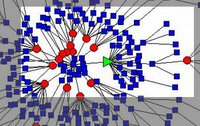Something about this metric rubs me the wrong way. I participate in a wide variety of groups, and I like to volunteer for things like "hospitality" and "registration." I
 get to introduce myself to lots of people that way. Take a look at this detail of my business introduction network, and notice all the red nodes. Each of those is a different group I participate in where I have met business colleagues. Uzzi and Dunlap would suggest that even when I work the registration desk for one of these red nodes, I am subconsciously selecting people similar to me every time I exchange business cards. When I follow up and get introduced by my new colleagues to their colleagues, then Uzzi and Dunlap suggest I am more likely to free myself from my unstoppable urge to "homophilize."
get to introduce myself to lots of people that way. Take a look at this detail of my business introduction network, and notice all the red nodes. Each of those is a different group I participate in where I have met business colleagues. Uzzi and Dunlap would suggest that even when I work the registration desk for one of these red nodes, I am subconsciously selecting people similar to me every time I exchange business cards. When I follow up and get introduced by my new colleagues to their colleagues, then Uzzi and Dunlap suggest I am more likely to free myself from my unstoppable urge to "homophilize."Uzzi and Dunlap are probably right, but I wish they talked more about how networks grow from the groups we participate in. Instead, readers must turn to the somewhat more scholarly article, "Where do social relations come from?" which was published in the most recent issue of Social Networks. The author does a careful analysis of just how many relationships typically from from "circles" (group membership) versus "sociability" (introductions through others) and finds 59% arise through circles.
Copyright (c) 2005 Connective Associates, except where otherwise noted.


2 comments:
Dear Mr. Hoppe,
I had a similar question about the 65% threshold that was cited in the article but on further contemplation, I believe the question about why self-introductions tend to "homophilze" relationships was addressed and supported by the research reviewed in the article. It definitely seemed to reveal to me the biases I was oblivous to in making my network ties, as well as why so many people's networks are "echo chambers;" namely, why so many of the average person's professional contacts are also contacts of each other.
Another issue that the article revealed for me was what constitutes a "contact." For Uzzi and Dunlap, it is someone you go to for professional advice and who you share private information. This changes the frame of reference on what is the make up of your network, which may explain why your view of network building and the authors' view diverge in the way you note. When I use their measure and your measure (someone you met are the "registraiton desk"), I get different pictures of my network. So, I think your observation here is dependent on how you quantify a tie.
Finally, the article you cite as better for understanding their network also requires that a person spend a lot more time and energy in analyzing their network. For my money, the simple and efficient tool created by Uzzi and Dunlop gives an excellent crude approximation that can be used to see whether a more costly approach is needed.
I too read the HBR article and thought it was a quick and easy way to get a new perspective on my network. It seems to me that the "homophily" you mention is dangerous precisely because it is so difficult to spontaneously recognize in our own networks, so I found the 65% measure helpful.
I also agree with an earlier post that discusses the difficulty of defining the term "contact." What I found particularly valuable about the article was the concept of shared activities, a way of forming strong and meaningful professional relationships, rather than the mundane exchange of business cards that we all tend to fall into.
Post a Comment